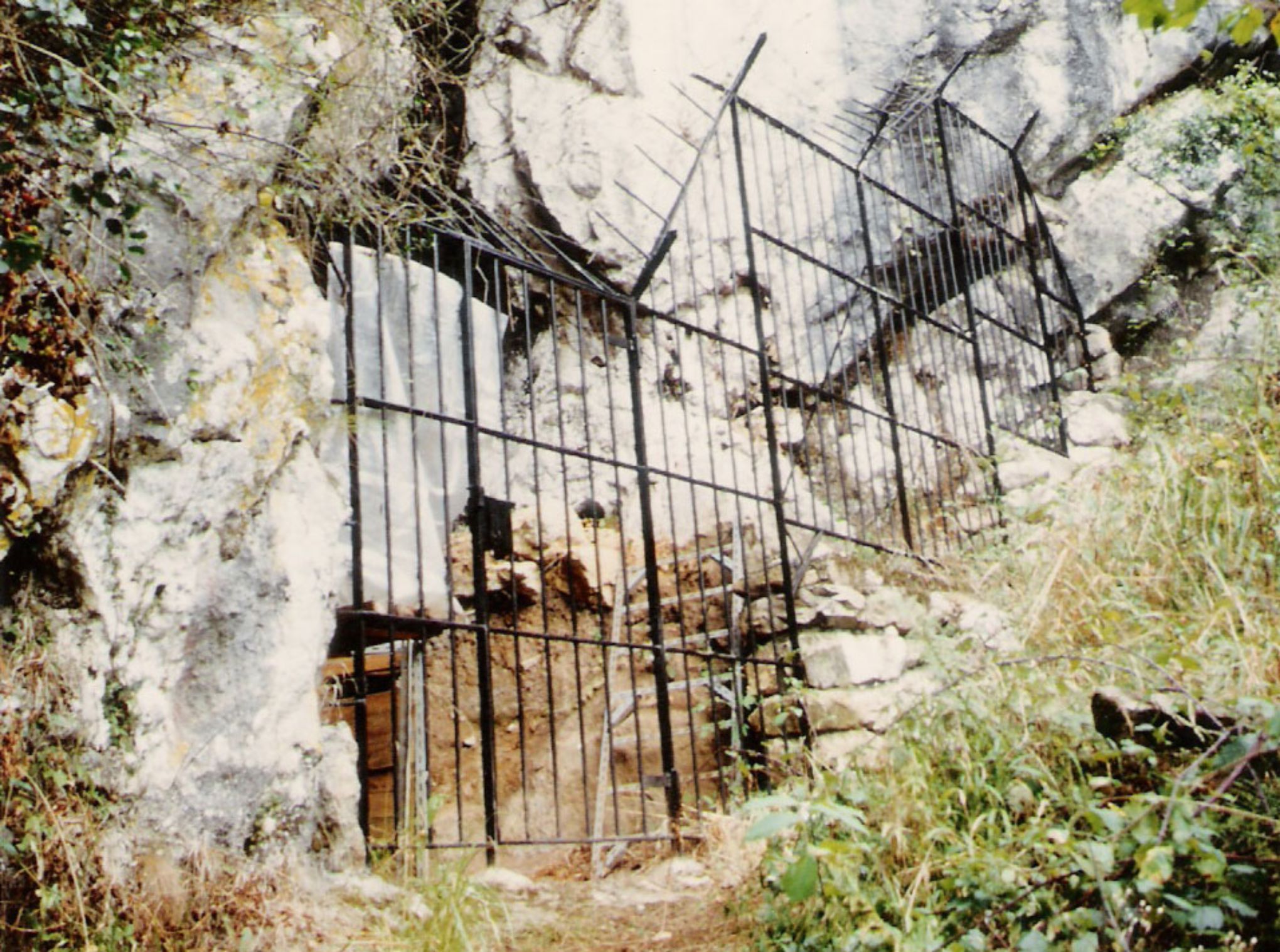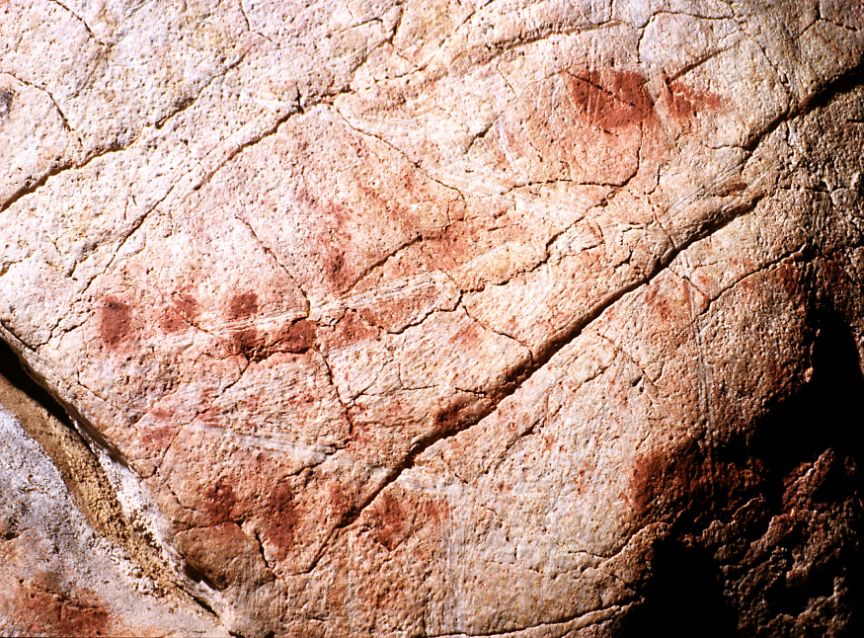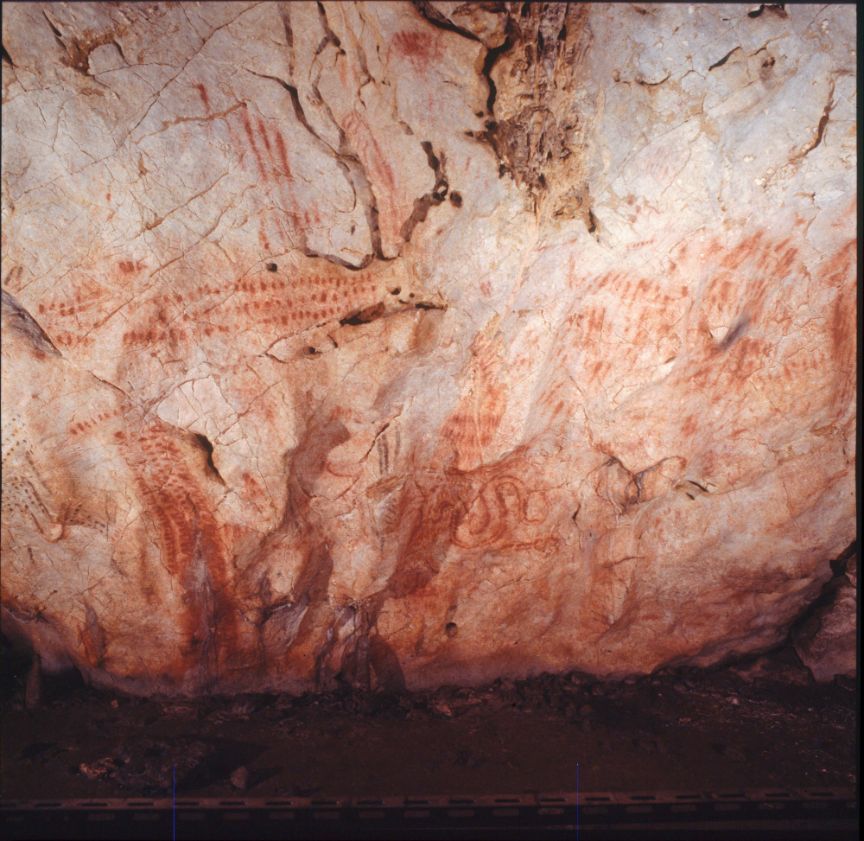Llonín Cave

Identification of the Property
SubirLa Molinuca, Peñamellera Alta, Principality of Asturias
Access
From the AS-114 road, turn on to the track in the village of La Molinuca.
Geographical coordinates
UTM 30T 366650E / 4798200N Z: 200
Description
SubirTopographic description
The cave is located in a narrow gorge cut by a tributary to the River Cares, on its left bank. The abrupt scenery forms part of the southern slopes of Sierra del Cuera. The cave consists of an ample vestibule, suitable for human occupation. To the south a high passage connects with the large, steeplysloping interior chamber. This has the greatest thickness of sediments, and all the cave art.
 Pulse para ampliar
Pulse para ampliar
Date of Discovery
Polifemo Caving Group discovered the existence of prehistoric art in the cave in 1971.
Archaeological research
M. Berenguer began the study of the art in Llonín Cave in the same year as its discovery. In 1984, J. Fortea took charge of the research, who carried out work on this site until 1998. The systematic excavations carried out by Fortea with M. de la Rasilla and V. Rodríguez have established a very long sequence of occupation, from the Middle Palaeolithic to the Bronze Age, taking in the techno-complexes of the final Gravettian, late Solutrean, the archaic, middle and late Magdalenian, and the Azilian. The Mousterian level revealed some very interesting anthropic structures made up of animal bones, brought by wolves and leopards, arranged in groups associated with lithic artifacts, in an evidently and intentionally planned association.
Artistic contents: paintings and engravings
A long process of fieldwork mapping the walls containing art has established a full record of this site, unique within the ensemble of Palaeolithic cave art in North Spain. By studying the superimpositions, five successive phases of artistic production have been detected on the main decorated wall in the cave:
- Bison in red, and numerous red signs.
- Black rectangular signs
- Hinds engraved with multiple lines in their outline and striated areas to shape their anatomy.
- Bisons and ibex painted and filled in black, with engraved outlines.
- Group of finely engraved ibex, horse and bison.
 Pulse para ampliar
Pulse para ampliar
The two latter phases could be contemporaneous, as one is not superimposed on the other anywhere on the wall.
On the entrance wall, a hind is painted in red, with the technique of dabbing dotted lines.
The chronology of these phases has been established by the use of stylistic parallels and the phases of occupation present in the archaeological deposit. Thus, Phase 1 is assigned to the Gravettian; Phases 2 and 3 to the late Solutrean and early Magdalenian periods; Phase 4 to the middle Magdalenian and Phase 5 to the late Magdalenian.
Bibliografía
SubirBERENGUER ALONSO, M. 1979. El arte parietal prehistórico de la Cueva de Llonín (Peñamellera Alta), Asturias. Boletín del Instituto de Estudios Asturianos.
FORTEA PÉREZ, F. J., RASILLA VIVES, M. DE LA, RODRÍGUEZ OTERO, V. 1991. Sobre un rodete perforado magdaleniense de Llonín (Asturias). Archivo de Prehistoria Levantina XX: 95-108.
FORTEA PÉREZ, F. J., RASILLA VIVES, M. DE LA, RODRÍGUEZ OTERO, V. 1992. La Cueva de Llonín (Llonín, Peñamellera Alta). Campañas de 1987 a 1990. Excavaciones Arqueológicas en Asturias 1987-1990: 9-18.
FORTEA PÉREZ, F. J., RASILLA VIVES, M. DE LA, RODRÍGUEZ OTERO, V. 1995. La Cueva de Llonín (Llonín, Peñamellera Alta). Campañas de 1991 a 1994. Excavaciones Arqueológicas en Asturias 1991-1994: 33-43.
FORTEA PÉREZ, F. J., RASILLA VIVES, M. DE LA, RODRÍGUEZ OTERO, V. 1999. La Cueva de Llonín (Llonín, Peñamellera Alta). Campañas de 1995 a 1998. Excavaciones Arqueológicas en Asturias 1995-98: 59-68
FORTEA PÉREZ, F. J., RASILLA VIVES, M. DE LA, RODRÍGUEZ OTERO, V. 2004. L’art pariétal et la séquence archéologique paléolithique de la grotte de Llonín (Peñamellera Alta, Asturies, Espagne). Préhistoire, Art et Sociétés LIX: 7-29.
FORTEA PÉREZ, F. J., RASILLA VIVES, M. DE LA, RODRÍGUEZ OTERO, V. 2007. La Cueva de Llonín (Llonín, Peñamellera Alta). Campañas de 1999 a 2002. Excavaciones Arqueológicas en Asturias 1991999-2002; 77-86.
GÓMEZ TABANERA, J. M. 1979. La cueva de Llonín y su integración en el campo de la arqueología y del arte prehistórico. Boletín del Instituto de Estudios Asturianos 96-97: 423-444.
HOYOS GÓMEZ, M. 1993. Procesos de alteración de soporte y pintura en diferentes cuevas con arte rupestre del Norte de España: Santimamiñe, Arenaza, Altamira y Llonín. La protección y conservación del arte rupestre paleolítico (Mesa Redonda hispano-francesa, Fundación Archivo de Indianos, Colombres, Asturias: 3-6 junio 1991): 51-74. Oviedo: Principado de Asturias.



